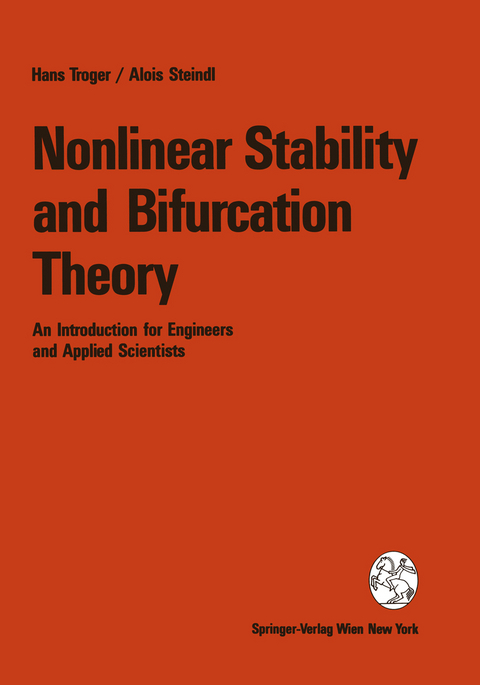
Nonlinear Stability and Bifurcation Theory
Springer Wien (Verlag)
978-3-211-82292-0 (ISBN)
Mittels der Methoden der Verzweigungs- und Singularitätstheorie wird eine systematische Behandlung nichtlinearer Stabilitätsprobleme statischer und dynamischer sowie endlich und unendlich-dimensionaler Systeme vorgestellt, wobei auf praktische Anwendungen der Theorie größter Wert gelegt wurde. Beispiele behandeln u.a. Beulprobleme, Fahrzeugbewegungen und strömungserregte Strukturen. Es werden keine besonderen mathematischen Voraussetzungen an den Leser gestellt, denn alle notwendigen Konzepte, die über das Grundwissen eines Ingenieurs hinausgehen, werden im Buch entwickelt.
Every student in engineering or in other fields of the applied sciences who has passed through his curriculum knows that the treatment of nonlin ear problems has been either avoided completely or is confined to special courses where a great number of different ad-hoc methods are presented. The wide-spread believe that no straightforward solution procedures for nonlinear problems are available prevails even today in engineering cir cles. Though in some courses it is indicated that in principle nonlinear problems are solveable by numerical methods the treatment of nonlinear problems, more or less, is considered to be an art or an intellectual game. A good example for this statement was the search for Ljapunov functions for nonlinear stability problems in the seventies. However things have changed. At the beginning of the seventies, start ing with the work of V.1. Arnold, R. Thom and many others, new ideas which, however, have their origin in the work of H. Poincare and A. A. Andronov, in the treatment of nonlinear problems appeared. These ideas gave birth to the term Bifurcation Theory. Bifurcation theory allows to solve a great class of nonlinear problems under variation of parameters in a straightforward manner.
1 Introduction.- 2 Representation of systems.- 2.1 Dynamical systems.- 2.2 Statical systems.- 2.3 Definitions of stability.- 3 Reduction process, bifurcation equations.- 3.1 Finite-dimensional dynamical systems.- 3.2 Infinite-dimensional statical and dynamical systems..- 4 Application of the reduction process.- 4.1 Equilibria of finite-dimensional systems.- 4.2 Periodic solutions of finite-dimensional systems.- 4.3 Finite- and infinite-dimensional statical systems.- 5 Bifurcations under symmetries.- 5.1 Introduction.- 5.2 Finite dimensional dynamical systems.- 5.3 Infinite dimensional statical systems.- 5.4 Infinite dimensional dynamical systems.- 6 Discussion of the bifurcation equations.- 6.1 Transformation to normal form.- 6.2 Codimension.- 6.3 Determinacy.- 6.4 Unfolding.- 6.5 Classification.- 6.6 Bifurcation diagrams.- A Linear spaces and linear operators.- A.1 Linear spaces.- A.2 Linear operators.- B Transformation of matrices to Jordan form.- C Adjoint and self-adjoint linear differential operators.- C.1 Calculation of the adjoint operator.- C.2 Self-adjoint differential operators.- D Projection operators.- D.1 General considerations.- D.2 Projection for non-self-adjoint operators.- D.3 Application to the Galerkin reduction.- E Spectral decomposition.- E.1 Derivation of an inversion formula.- E.2 Three examples.- F Shell equations on the complete sphere.- F.1 Tensor notations in curvilinear coordinates.- F.2 Spherical harmonics.- G Some properties of groups.- G.1 Naive definition of a group.- G.2 Symmetry groups.- G.3 Representation of groups by matrices.- G.4 Transformation of functions and operators.- G.5 Examples of invariant functions and operators.- G.6 Abstract definition of a group.- H Stability boundaries in parameter space.- I Differential equation of anelastic ring.- I.1 Equilibrium equations and bending.- I.2 Ring equations.- J Shallow shell and plate equations.- J.1 Deformation of the shell.- J.2 Constitutive law.- J.3 Equations of equilibrium.- J.4 Special cases.- J.4.1 Plate.- J.4.2 Sphere.- J.4.3 Cylinder.- K Shell equations for axisymmetric deformations.- K.1 Geometrical relations.- K.2 Stress resultants, couples and equilibrium equations.- K.3 Stress strain relations.- K.4 Spherical shell.- L Equations of motion of a fluid conveying tube.- L.1 Geometry of tube deformation.- L.2 Stress-strain relationship.- L.3 Linear and angular momentum.- L.4 Tube equations and boundary conditions.- M Various concepts of equivalences.- M.1 Right-equivalence.- M.2 Contact equivalence.- M.3 Vector field equivalence.- M.4 Bifurcation equivalence.- M.5 Recognition problem.- N Slowly varying parameter.- O Transformation of dynamical systems into standard form.- O.1 Power series expansion.- O.2 Recursive calculation.
| Erscheint lt. Verlag | 15.10.1991 |
|---|---|
| Zusatzinfo | XI, 407 p. |
| Verlagsort | Vienna |
| Sprache | englisch |
| Maße | 170 x 244 mm |
| Gewicht | 650 g |
| Themenwelt | Mathematik / Informatik ► Mathematik ► Angewandte Mathematik |
| Naturwissenschaften ► Physik / Astronomie ► Mechanik | |
| Technik ► Bauwesen | |
| Schlagworte | Bifurkationstheorie • Chaos • Deformation • differential equation • Dynamical Systems • Geometry • Mechanics • Model • Modeling • Operator • Singularitätstheorie • Stabilität (Statik) • stability • Transformation |
| ISBN-10 | 3-211-82292-5 / 3211822925 |
| ISBN-13 | 978-3-211-82292-0 / 9783211822920 |
| Zustand | Neuware |
| Haben Sie eine Frage zum Produkt? |
aus dem Bereich


